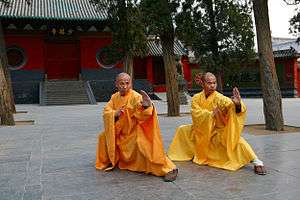Yuejiaquan
Yuejiaquan (岳家拳, literally Yue Family Fist, alternately Yue Ch'uan) is a style of Chinese martial arts attributed to Yue Fei, a noted General and patriot from the Song Dynasty.
| Also known as | Yue family Fist/Boxing |
|---|---|
| Focus | Striking, Chin Na, weapons training |
| Country of origin | |
| Creator | Yue Fei (attributed) |
| Famous practitioners | Ng Mui[1] |
| Parenthood | Eagle Claw, Chin Na |
| Descendant arts | Xing Yi Quan |
| Part of a series on |
| Chinese martial arts (Wushu) |
|---|
 |
| Wushu in the world |
|
Historical locations
|
| Wushu athletes/practitioners |
|
Legendary figures
|
|
Historical individuals
|
|
Modern celebrities
|
| Wushu influence |
History and philosophy
Legend claims Yue taught the style to his soldiers who passed it down for generations after his death. It contains mostly military-oriented attacks, and is based primarily upon the principles of combining internal and external techniques, theory and application. Its various tricks stem from its principal philosophy of the positive and negative and the five elements of the heart, liver, lung, spleen and kidney in the human body. This art created by Yue Fei includes Eagle Claw Chin Na submissions and other fighting techniques that would later become the basis of the creation of Xing Yi Quan.[2]
In popular culture
The style is mentioned towards the end of Yue Fei's highly popular folklore biography The Story of Yue Fei published in 1684.[3] In the novel, Yue Lei, Yue's second son, uses the style in a brawl against the martial instructor of a group of bandits who forcefully took over residence of a local Taoist temple to Lord Guan. During the fight, "The instructor went forward one step to catch up with Yue Lei. Yue Lei turned around and used his right hand to push away his opponent's two hands whilst using his left hand to give a push on the chest. The instructor was startled and quickly dodged the blow, shouting, 'Stay your hands! This is the Yue Family's Pugilistic Fight. Where did you learn this from? I beg for your name!'"[4] After Yue learns the instructor is Zhong Liang, the grandson of the famous Song General Zhong Ze, Zhong muses: "My family and the Yue family have been friends for three generations. Commander Yue had often discussed pugilistic skills with my father [Zhong Fang], so I could recognize your move as 'The Black Tiger's Theft of the Heart,' which comes from the Yue Family."[4]
References
- Robert Chu, Rene Ritchie & Y. Wu (2015). Complete Wing Chun: The Definitive Guide to Wing Chun's History and Traditions. Tuttle Publishing. ISBN 14-6291-753-4.
- Randell Stroud (2010). SanshouXingYiQuan: & Commentaries on Modern Martial Arts. ISBN 05-5758-753-0.
- Hegel, Robert E. Reading illustrated fiction in late imperial China. Stanford University Press,1998, p. 47
- Qian, Cai. General Yue Fei: A Novel. Tr. T.L. Yang. Joint Publishing (H.K.) Co. LTD., 1995, pp. 744-745